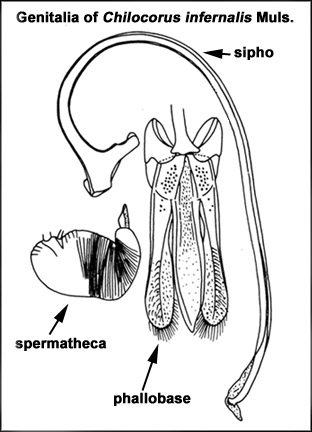| Aggregation of pupae | Adult | Adult |
|
Chilocorus infernalis Mulsant |
Nomenclature
Chilocorus infernalis Mulsant, 1853a: 189.
Chilocorus bijugus Mulsant, 1853a: 189; 1853b: 61.-Crotch, 1874: 183.-Korschefsky, 1932: 242.
Chilocorus bijugus infernalis: Korschefsky, 1932: 242.
Diagnosis

Length 4.3-6.0 mm, width 4.0-5.0 mm. Form obovate, posteriorly narrowed, strongly convex. Ground colour uniformly shiny black, sometimes with a greenish tinge, each elytron with a pair of reddish testaceous or orange yellow spots a little before middle in anterior half, outer spot usually smaller than inner spot, rarely subequal. Male genitalia and female spermatheca as illustrated.
Distribution
India: Himachal Pradesh; Jammu & Kashmir; Meghalaya; Uttar Pradesh. Pakistan. Nepal. Himalayas. Introduced and established in parts of Russia.
Prey/associated habitat
HOMOPTERA: Aleyrodidae: citrus whitefly. Aphidoidea: Adelges sp., Aphis pomi De Geer, Brachycaudus helichrysi (Kaltenbach), Eriosoma lanigerum (Hausmann). Coccoidea: Aonidiella aurantii (Maskell), Ericerus pela (Chavannes), Diaspidiotus prunorum (Laing), Lepidosaphes afganensis Borchsenius, Lopholeucaspis japonica (Cockerell), Metaceronema japonica (Maskell), Parlatoria ziziphi (Lucas), Diaspidiotus perniciosus (Comstock), Tecaspis sp., Unaspis yanonensis (Kuwana). Collected in association with scales on apple, pear, peach, and other temperate fruits, olive, citrus, Olea cuspidata, willow, mulberry, etc.
Seasonal occurrence
Active during May-September in northwestern and northeastern regions of India. Very effective in the early months of summer in Kashmir. Collected during April-May, July and October in northern India.
Natural enemies
Homalotylus sp. Heavily parasitized by a number of chalcid and eulophid parasitoids from the end of July in Kashmir.
References
Ahmad,
R. & Ghani, M.A. 1966. Biology of Chilocorus
infernalis Muls. (Col.: Coccinellidae). Technical
Bulletin, Commonwealth Institute of Biological Control, 7, 101-106.
Kapur, A.P. 1956. Systematic and biological notes on the ladybird beetles
predacious on the San Jose scale in Kashmir with description of a new species (Coleoptera:
Coccinellidae). Records of the Indian
Museum 52 (1954):
257-274.
Nagaraja,
H. & Hussainy, S.U. 1967. A study of six species of Chilocorus (Coleoptera: Coccinellidae) predaceous on San Jose and
other scale insects. Oriental Insects
1: 249-256.
Pang,
X.F. & Mao, J.L. 1979. Coleoptera: Coccinellidae, II. Khongguo Jingi Kunchang Zhi 14:
1-170.